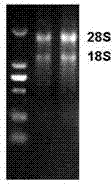Safflower Chalcone Isomerase Chi Gene and Its Application
A chalcone isomerase, gene technology, applied in the application, genetic engineering, plant genetic improvement and other directions
- Summary
- Abstract
- Description
- Claims
- Application Information
AI Technical Summary
Problems solved by technology
Method used
Image
Examples
Embodiment 1
[0017] Example 1 Safflower Petal RNA Extraction
[0018] Sow the seeds of safflower "Tacheng safflower" (purchased in Tacheng, Xinjiang) in a nutrient bowl filled with sand, and cultivate them under appropriate conditions in an intelligent artificial climate chamber to collect safflower petals.
[0019] 1) Wrap the tweezers, mortar, pestle and medicine spoon with tinfoil, put them in a 180°C oven for 4 hours for dry heat sterilization, and set aside;
[0020] 2) Treat 1.5mL centrifuge tubes and pipette tips with 0.1% DEPC water overnight, then autoclave at 120°C for 20 minutes, and place them in an oven at 60°C to dry for later use;
[0021] 3) Take about 100 mg of safflower petals, add liquid nitrogen and quickly grind to fine powder, divide into two 1.5mLEP tubes, add 1mL RNAiso Plus to each, mix well, and let stand at room temperature for 5 minutes;
[0022] 4) Centrifuge at 12000rpm for 5min at 4°C, transfer the supernatant to a new 1.5mL centrifuge tube;
[0023] 5) A...
Embodiment 2
[0031] Example 2 Synthesis of the first strand cDNA
[0032] The RNA stored at -80°C was taken, and the concentration of RNA was detected by nanogrop. The concentration of extracted RNA was all about 1000ng / ul. Reverse transcription of cDNA was carried out according to the operating instructions of the reverse transcription kit. The reverse transcription reaction system is shown in Table 1 and Table 2. The cDNA after reverse transcription was stored in a -20°C refrigerator for later use.
[0033]
[0034] Carry out the reaction on the PCR instrument: 65°C, 5min, and quickly cool it on ice.
[0035]
[0036] Reverse transcription reaction conditions: 42°C for 55 minutes, 70°C for 10 minutes, place on ice to cool, obtain cDNA for subsequent reactions, and freeze at -20°C for future use.
Embodiment 3
[0037] Example 3 Cloning of the Middle Fragment of the CHI Gene
[0038] According to the candidate genes selected from the sequencing results of safflower 454 in our laboratory, specific primers (Table 3) were designed to verify the intermediate fragments. According to the middle fragment of the verified CHI gene, design primers (Table 3) for full-length gene cloning. According to the splicing and alignment of the safflower petal 454 sequencing results, the middle fragment sequence of the CHI gene was obtained, and a 209bp middle fragment was amplified by RT-PCR ( figure 2 A), RT-PCR reaction system is shown in Table 4. After gel recovery, it was connected to the cloning vector pEASY-T1 (Beijing Quanshijin Biotechnology Co., Ltd.), and further passed bacterial liquid PCR ( figure 2 B) and Eco R I , Han dIII digestion identification ( figure 2 C), the sequencing result is correct.
[0039]
[0040]
PUM
 Login to View More
Login to View More Abstract
Description
Claims
Application Information
 Login to View More
Login to View More - R&D
- Intellectual Property
- Life Sciences
- Materials
- Tech Scout
- Unparalleled Data Quality
- Higher Quality Content
- 60% Fewer Hallucinations
Browse by: Latest US Patents, China's latest patents, Technical Efficacy Thesaurus, Application Domain, Technology Topic, Popular Technical Reports.
© 2025 PatSnap. All rights reserved.Legal|Privacy policy|Modern Slavery Act Transparency Statement|Sitemap|About US| Contact US: help@patsnap.com



